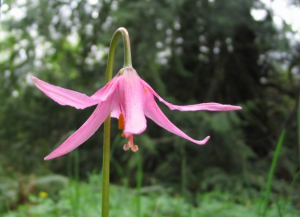
News/Reports
Honeymoon Bay ER #113 Overview: Physical and Biological
Original Purpose:
To preserve showy stands of the rare  fawn lily.
fawn lily.
Physical: The reserve is located where Sutton and Millar creeks issue from the
Vancouver Island mountains, depositing alluvial materials in a reach of reduced gradient, 1.5 km upstream from the creek mouth at Cowichan Lake. Sutton Creek winds through the middle of the reserve. Soils are primarily Regosols developed on floodplain deposits. The climate is mild
and moist.
Biological: One of the major features of this ER is large population of the pink fawn
lily (Erythronium revolutum), a delicate wildflower most common on western Vancouver Island, but also found on Valdes Island and in the Kingcome Inlet and Port Renfrew areas. This species is considered to be uncommon in the province. It prefers moist alluvial sites in moderately open woodland, particularly containing deciduous trees like bigleaf maple and red alder. Such conditions are ideally represented in the reserve,
where the characteristic association is a bigleaf maple-red alder-fawn lily,yellow violet type. The fawn lilies require four to six years from seed to blooming plant, and the slender corms perish if the leaves are picked. Dense cluster of these striking flowers bloom here primarily in April. Slightly higher ground away from the creek supports seral coniferous forest stands in which western hemlock, western redcedar, and Douglasfir are present. Additional wildflowers in the reserve are trillium, red columbine, wild ginger, bleeding heart, false lily-of-the-valley, star-lowered false Solomon’s-seal, clasping twistedstalk, Smith’s fairybells,
California-tea—Blue listed
Ermine, ssp. anguinae—Blue listed
Dolly Varden—Blue listed
Cutthroat Trout, ssp. clarkii—Blue listed
clasping twistedstalk
Coho Salmon
pink fawn lily,and buttercups. Ferns of several species are well represented.
THREATS
Climate Change: The protected flowers in this reserve grow well in relatively
wet, alluvial sites. This site may remain as such, or may become drier due to warming and changes in hydrology. The area may be further colonized by coniferous forest
stands as growing degree days increase and the changing climate alters the distribution of plant and forest communities.
Recent large flood events along with the presence of the upstream bridge have created a severe erosion issues on the north bank of Sutton Creek within the ER. Non-native species: Aggressive invasive carpet burweed is a threat. Recreation: Unofficial trail system is established and harms native wildflowers due to trampling. Transportation corridors: Bridge abutments constrict Sutton Creek flow which prevents natural flooding processes required to limit stand
conversion (Big-leaf maple to conifer), as well as maintain the nutrient value necessary for wildflower propagation.
Non-native species: Aggressive invasive carpet burweed is a threat. Recreation: Unofficial trail system is established and harms native wildflowers due to trampling.
Transportation corridors: Bridge abutments constrict Sutton Creek flow which prevents natural flooding processes required to limit stand conversion (Big-leaf maple to conifer), as well as maintain the nutrient value necessary for wildflower propagation. Southside Road follows the northern boundary of the reserve, and Honeymoon Bay industrial road follows the western boundary.
Flora
alder, red (Alnus rubra)
baneberry (Actaea rubra)
bleeding heart,(Dicentra formosa)
buttercup, (Ranunculus sp.)
California-tea (Rupertia physodes)
columbine, red (Aquilegia formosa)
fairybells, Smith’s (Prosartes smithii)
ginger, wild (Asarum caudatum)
hemlock, western (Tsuga heterophylla)
lily, pink fawn (Erythronium revolutum)
lily-of-the-valley, false (Maianthemum dilatatum)
maple, bigleaf (Acer macrophyllum)
redcedar, western (Thuja plicata)
Solomon’s-seal, star-flowered false (Maianthemum stellatum)
trillium (Trillium ovatum var. ovatum)
twistedstalk, clasping (Streptopus amplexifolius)
violet, yellow (Viola sp.)
INVASIVE
burweed , carpet (Soliva sessilis)
Fauna
Bear, American Black (Ursus americanus)
Chickadee, Chestnut-backed (Poecile rufescens)
Creeper, Brown (Certhia americana)
Cougar (Puma concolor)
Dolly Varden (Salvelinus malma)
Ermine, anguinae subspecies (Mustela erminea anguinae)
Junco, Dark-eyed (Junco hyemalis)
Raven, Common (Corvus corax)
Salmon, Coho (Oncorhynchus kisutch)
Trout, Cutthroat (Oncorhynchus clarkii clarkii)
